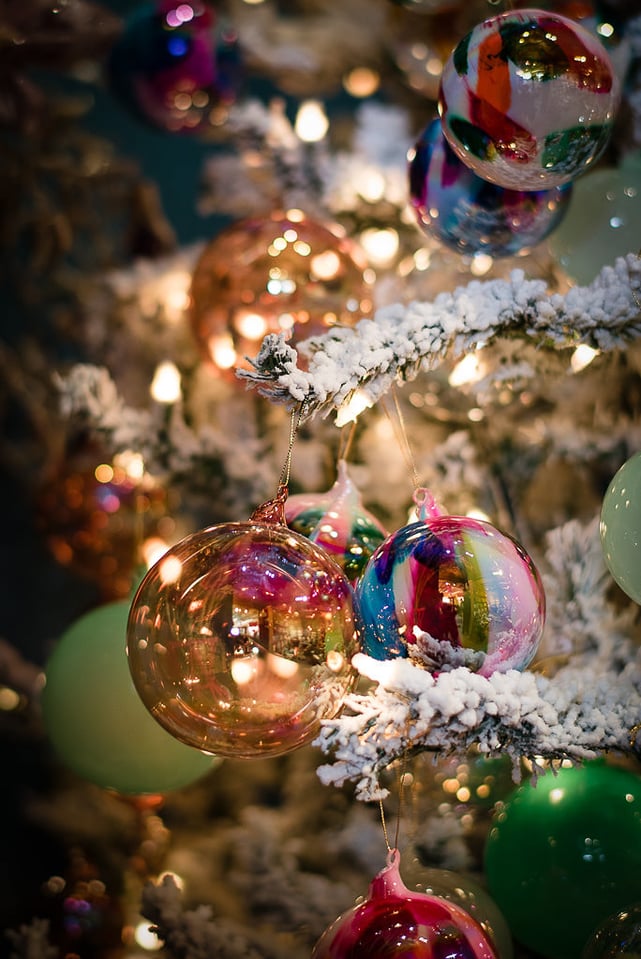Bokeh, also known as “Boke” is one of the most popular subjects in photography. The reason why it is so popular, is because Bokeh makes photographs visually appealing, forcing us to focus our attention on a particular area of the image. The word comes from Japanese language, which literally translates as “blur”.

Table of Contents
What is Bokeh?
Basically, bokeh is the quality of out-of-focus or “blurry” parts of the image rendered by a camera lens – it is NOT the blur itself or the amount of blur in the foreground or the background of a subject. The blur that you are so used to seeing in photography that separates a subject from the background is the result of shallow “depth of field” and is generally simply called “background blur”. The quality and feel of the background/foreground blur and reflected points of light, however, is what photographers call Bokeh. Confused yet? Take a look at the following image:

The house sparrow is in focus and sharp (which means that it is inside the depth of field), while the background is out of focus (which means that the background is outside the depth of field). The small or “shallow” depth of field is the result of standing relatively close to the subject, while using a large aperture.
See those round circles of different colors on the left side of the image? Those are light reflections and they are circular because that’s how the lens rendered them. In this case, the soft “feel” of those circular areas is what photographers would call “good bokeh”. While some photographers argue that bokeh is just about the quality of the circular light reflections, many others, including myself, believe that bokeh is about the quality of the entire out-of-focus area, not just reflections and highlights…
Good and Bad Bokeh
Remember, bokeh is rendered by the lens, not the camera. Different lenses render bokeh differently due to unique optical designs. Generally, portrait and telephoto lenses with large maximum apertures yield more pleasant-looking bokeh than cheaper consumer zoom lenses.
For example, the Nikon 85mm f/1.4D lens produces exceptionally good-looking bokeh, while the Nikon 18-135mm f/3.5-5.6G DX lens produces poor bokeh at the same focal length and aperture – all due to differences in optical designs of both lenses. Again, I am not just talking about the background blur; all lenses are capable of producing out of focus blur, but not all lenses are capable of rendering beautiful bokeh.
So, what is a good or beautiful bokeh? A good bokeh pleases our eyes and our perception of the image and therefore, the background blur should appear soft and “creamy”, with smooth round circles of light and no hard edges. Here is an example of beautiful bokeh rendered by the Nikon 85mm f/1.4D lens:

Pay attention to the smooth background behind the child’s face. The out-of-focus areas look creamy and the circles are round and soft with beautiful transitions between the blurry areas. That’s exactly what you would call good bokeh!
How about bad or ugly bokeh? Although a lot of people argue that there is no such thing as a bad bokeh, I still call whatever distracts my eyes “bad”:

Open up the larger version of the above image and see for yourself – the quality of the blur is not pleasant to the eye, with sharp edges of the circles and double lines.
Bokeh Shapes
The shape of the reflected light in out of focus areas depends on the lens diaphragm. Many older lenses such as Nikon 50mm f/1.4D have straight blades in their diaphragms, whereas newer lenses often have rounded blades. Rounded blades, along with more blades, more closely approximates a perfect circle at all apertures. Take a look at a lens with 6 straight blades, 7 straight blades, and 7 rounded blades:

And here is the Nikon 105mm f/2.8G VR with 9 rounded blades that renders very round bokeh:

The smoothness and roundness of these out-of-focus specular highlights directly affects bokeh, since the out of focus areas are made up of many small circles like this. Notice also that is not just the shape of the circles that matters: if a lens is not well-correct for chromatic aberrations, then these will show up in the out-of-focus areas making the bokeh worse.
How to Get Good Bokeh
So, how do you get good bokeh in your images? As I have pointed out above, bokeh depends on the type of lens you are using. While lower-end consumer zoom lenses will yield unpleasant bokeh, fixed (prime) lenses and most professional zoom lenses with fast apertures yield good-looking bokeh.
But that doesn’t mean that you can’t create good bokeh if your lens has some unpleasant characteristics. If you don’t have rounded aperture blades, you can shoot wide open (at your lens’s maximum aperture) so that your bokeh circles are still round.
Or, if your bokeh circles look a little strange, you can avoid strong points of light and choose more uniformly-lit backgrounds to get smoother, creamier backgrounds. Keeping your background farther away will also result in less detail in your out-of-focus areas, which in turn will make it easier for your lens to render nice bokeh.
In general, some situations will reveal bad bokeh more easily than others, and you should get to know these situations for your particular lens so you can avoid them. I would also suggest reading 10 Tips for Better Bokeh in Photography for even more ideas on making great bokeh.
What Lenses Create Great Bokeh?
Do you know if your lens produces good bokeh? Try this: focus on an object from a very close distance (as close as the lens will allow, keeping the object in focus), making sure that there are no objects at least 5-6 feet behind it. Make sure to be on the same level as the object itself, so that you are not looking down on it. Do not use a plain wall as your background – try to find a colorful background, preferably with some lights on it. A Christmas tree is a perfect background for a bokeh test. Out-of-focus trees outside also are great because they have plenty of specular highlights coming through leaves and branches.

Once you find a good test subject with a suitable background, set your camera to “Aperture Priority” mode and set your aperture to the lowest number. On most consumer zoom lenses, the lowest aperture is typically f/3.5, while on prime and professional zoom lenses, it can be between f/1.2 and f/2.8. Once the aperture is set to the lowest value, take a picture of your subject and take a look at the rear LCD of your camera. The subject should be in focus, while the background is blurred. If you have a good lens, the bokeh should be soft and fuzzy, looking pleasing to the eye as shown in the example above. The circular reflections should be round and soft, with no hard edges.
There are many lenses that create great-looking bokeh. Most fast prime lenses with round-blade apertures such as Nikon 85mm f/1.8S or Canon 85mm f/1.2 II USM create exceptionally good-looking bokeh. The DSLR version of the same lens – Nikon 85mm f/1.8G and Canon 85mm f/1.8 USM also produce beautiful bokeh.

In general, higher-end primes that are intended for portraits will have decent to excellent bokeh. Zooms tend to have optical compromises in some cases like our recently-reviewed Nikon Z 24-120mm f/4 S, although faster aperture zooms like 70-200 f/2.8 lenses tend to fare better.
Supertelephoto primes like the Nikon 400mm f/4.5 S and Nikon 400 f/2.8 S recently compared by Libor also tend to have fairly excellent bokeh, which is great since these lenses frequently are used in situations that stress a lens’ bokeh characteristics. On the other hand, Nikon’s PF telephoto lenses like the 500mm f/5.6 PF sometimes show unusual bokeh with specular highlights.
Lenses that typically aren’t used to produce bokeh sometimes also have weird or busy bokeh. This especially applies to wide-angle lenses that can still blur backgrounds if you get very close to your subject with them.

Aside from these guidelines, each lens will have subtle individual characteristics that affect bokeh. If you’re thinking of buying a lens, reading reviews here is a great starting point to understand any weaknesses and strengths your potential lens may have.
Other Examples of Bokeh
Here are some other examples of great-looking bokeh:




Just to get some facts right. Bokeh (or Circle-Of-Confusion) isn’t something that is built into the lens on purpose. Bokeh is a sign of imperfection in the optic. These dots appear when the focal point isn’t in the exact right position. Hence an expensive “perfect” lens would have almost no bokeh effect. The more set of lenses an objective have, the higher risk of not aligning them all perfect when zooming. A fixed objective have a high chance to generate less bokeh effect due to less number of lenses and no moving parts for zoom.
Lenses that are poorly corrected for spherical aberration will show one kind of disc for out-of-focus points in front of the plane of focus, and a different kind for points behind.
Hitam
How can you get a decent bokeh effect with our iPhone? Or is it possible? I have used Camera Plus and it has a depth of field when editing that helps. Thanks
You can by using the portrait mode and/or making the depth of field shallower on the iPhone. It will be fake but passable.
And I want to get rid of bokeh. If I visit a city as a tourist, I usualy do not need bokeh, I need whole foto in focus.
The best thing then is to use a wide-angle lens and stop down to f/8 or f/11.
The examples and descriptions of depth of field along with focal length are some of the best I’ve encountered researching this. This article is superbly written. It inspired me to visit Jason’s website.
Curious if you can recommend techniques for “good” bokeh whennusing a non-professional lens.
Thanks. This is the best explanation of Bokeh.
Very helpful article. I do mainly extreme close-up photography so bokeh is very important to me. I love to shoot common subjects in a way that the viewer has never seen it before. Many of my best photographs are when the viewer has to ask “what is that” and when I tell them they are totally surprised.
I have just purchased a Nikon coolpix p950 and would like to beable to do Bokeh but don’t know how any suggestions
Good article thank you!
I am just about to start learning. I have bought a Panasonic Lumix G9 with a 12-60mmm Leica lens and I have also a 25mm f1.7 prime lens with the package. I am reading lots before I attempt to start taking any photos. Hopefully this kit will allow me to get some good and interesting shots. I really wanted it to shoot 4k video for web content etc, but the photography side is a mine field with a large learning curve, however articles like this which break things down in to lamen’s terms are very helpful, so thanks again.
Regards Bobby